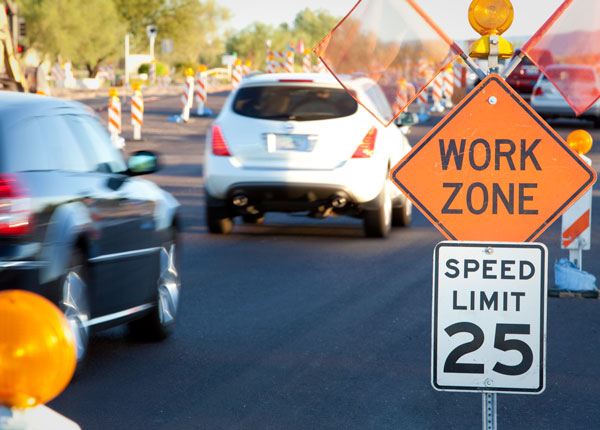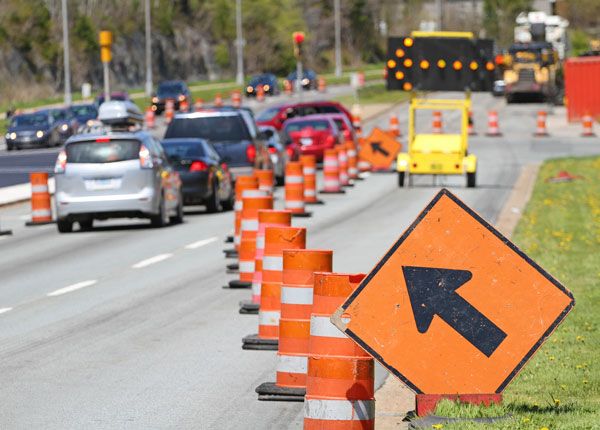
Work Zone Driving Rules: Road Signs, Right-of-Way, Speed Limit & Penalties
Updated Aug. 14, 2020Most roadway construction and maintenance projects around the United States are conducted without completely closing the road to traffic. Often, it is high-traffic roadways such as urban highways and city streets that require repairs or development, as they are subject to greater wear and strain than less well-traveled areas. Closing such busy stretches of road would cause severe disruption to commuters – it is for this reason that they are generally left open while the work is being carried out. Unfortunately, road work zones pose a significant hazard to drivers, their passengers and the construction or maintenance workers occupying the site.
The complex risk environments created by roadway work zones around America resulted in some 96,626 crashes in 2015 alone. This amounts to one crash every 5.4 minutes. While many of these incidents only resulted in property damage, a large number lead to injuries or fatalities:
- 70 work zone crashes resulted in at least one injury EVERY DAY.
- 12 work zone crashes resulted in at least one fatality EVERY WEEK.
- A total of 712 fatalities occurred as a result of work zone crashes in 2015.
Understanding work zones
The term “work zone” refers to any area on a public road where utility, construction or maintenance work is being conducted. Work zones are often unanticipated by drivers and usually involve lane closures or obstacles. As a result, they generally hinder the flow of traffic to some degree.
There may be barriers, cones, heavy equipment, temporary signs, signal lights and workers in the roadway, prior to, during and beyond work sites. Furthermore, roadway work zones may be stationary (when an interchange is built) or mobile (when road markings are painted), making it difficult to determine where the danger begins and ends.
Most work zone crashes are caused by irresponsible or distracted drivers. As a motorist, you have a responsibility to abide by all signs, signals and traffic control measures established around roadway work zones, and to navigate these areas with the utmost caution.
Signs, signals and channeling devices
In nearly all cases, traffic signs and control devices are set up in and around a work zone to direct motorists. These may include channeling devices such as cones, drums and barricades, temporary road markings, portable signs, electronic message boards and arrow boards. Keep in mind that warning signs around work zones are generally orange. There may also be flaggers or other traffic control workers in the roadway directing vehicles.
This amounts to a great deal of information to take in. Plus, the instructions given by these signs and signals will likely contradict the way you would usually drive on this road prior to the work zone being established. We should also point out that these traffic control measures could change daily, as the project progresses.
Driving through work zones
When approaching a work zone, reduce your speed and check the road ahead for slowing or stopped traffic. Look out for diversions and pay attention to traffic signs and signals. If there are police officers, flaggers or other workers in the road directing traffic, you must follow their instructions implicitly.
In addition, consider these work zone safety rules:
- 1

Look out for signs indicating lane closures ahead.
You may need to merge into a different lane or make way for drivers merging into your lane. - 2

Stick well within the speed limit.
In many states, drivers are subject to double the usual fine when caught exceeding the speed limit around a work zone. - 3

Pay attention to other motorists.
Not all drivers will behave responsibly around work zones. - 4

Avoid making any sudden maneuvers.
- 5

Yield the right-of-way to any work zone vehicles.
Road work vehicles equipped with revolving or flashing amber lights have the right-of-way. Drive slowly near these vehicles. - 6

Do not brake suddenly.
Keep moving with the flow of traffic. - 7

Do not weave between lanes.
- 8

Be mindful of changing road surface conditions.
If digging or resurfacing work is being conducted, you may have to deal with rougher pavements, uneven surfaces or metal plates. Drive in a slow and controlled manner. - 9

Maintain space around your vehicle.
Driving too close to the vehicle in front may leave you with nowhere to go if they stop suddenly. - 10

Always be patient.
Treat road workers and other road users courteously.
You may be able to reduce your speed and move through a work zone without stopping. Though in many cases, traffic must be stopped before moving through a work zone. This will probably be the case if a single lane remains open to traffic moving in both directions or when dangerous activity limits the space on the roadway which can safely be occupied by motorists. Always be prepared to stop when approaching a work zone.
Yielding to mobile work vehicles
Some improvement and maintenance projects can be undertaken without closing any part of the roadway to traffic. Such tasks include road patching, road painting, debris removal, snow removal and utility work. In these instances, the work will usually be carried out by a slow-moving vehicle displaying flashing amber lights. Mobile work vehicles may also be equipped with warning signs or flashing directional arrows, instructing motorists to merge left or right.
Drivers must slow down considerably when approaching work vehicles, as they typically travel at speeds of around five mph. Begin to reduce your speed as soon as you spot a work vehicle in the roadway ahead, as you will close the distance quickly. Avoid sudden maneuvers and remember that mobile work vehicles always have the right-of-way.
Double or increased fines
Nearly all states have chosen to discourage dangerous driving around high-risk work zones by increasing or doubling the fines incurred by traffic violations. In some cases, the “double fine” rule applies to individual violations such as speeding, whereas in others, it refers to all moving traffic violations. Your state’s driver manual will include a break-down of work zone fines as they apply to your area – make sure you check out this information.
Understand that many high-risk work zones are under surveillance or will have an increased law-enforcement presence. With these extra measures taken to protect road users and construction workers, you are considerably more likely to be caught breaking the rules.





